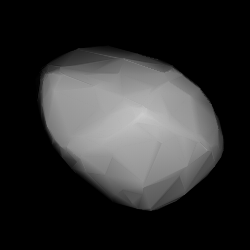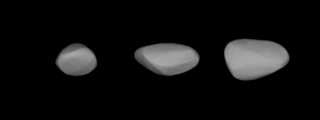Related Research Articles

Zelia is a main belt asteroid that was discovered by the brothers Paul Henry and Prosper Henry on September 28, 1876. Credit for this discovery was given to Prosper. Initial orbital elements for this asteroid were published in 1877 by American astronomer H. A. Howe.

Lucia is a large Themistian asteroid. It was discovered by Johann Palisa on 9 February 1882 in Vienna and named after Lucia, daughter of Austro-Hungarian explorer Graf Wilczek.

Goberta is a mid-sized Themistian asteroid that was discovered by French astronomer Auguste Charlois on 8 September 1891 in Nice.
Caprera is a minor planet orbiting the Sun.
Seppina is a minor planet orbiting the Sun.
Laodica is a minor planet orbiting the Sun.
Mabella is a minor planet orbiting the Sun.

Sara is a minor planet orbiting the Sun.

Nassovia is a minor planet orbiting the Sun. It is a member of the Koronis family of asteroids.
Misa is a minor planet orbiting the Sun.
Bandusia is a minor planet orbiting the Sun.
Luisa is a minor planet orbiting the Sun.
625 Xenia is a minor planet orbiting the Sun. It was discovered by August Kopff in Heidelberg, Germany, on 11 February 1907. The name may have been inspired by the asteroid's provisional designation 1907 XN.
635 Vundtia is a minor planet orbiting the Sun - though this claim has been disputed.

695 Bella is a minor planet orbiting the Sun.
733 Mocia is a minor planet orbiting the Sun. A possible occultation was observed by Oscar Canales Moreno on October 1, 2001.

787 Moskva is a minor planet orbiting the Sun. It is a dynamic member of the Maria asteroid family orbiting near the 3:1 Kirkwood gap. This is an S-type (stony) asteroid spanning 27 km. The surface mineralogy is consistent with mesosiderite silicates.
6144 Kondojiro (1994 EQ3) is an asteroid discovered on March 14, 1994 by Kin Endate and Kazuro Watanabe at the Kitami Observatory in eastern Hokkaidō, Japan. It is named after Jiro Kondo, a Japanese Egyptologist and professor of archaeology at Waseda University.
2021 LL37 is a large trans-Neptunian object in the scattered disc, around 600 kilometres (370 miles) in diameter. It was discovered on 12 June 2021, by American astronomers Scott Sheppard and Chad Trujillo using Cerro Tololo Inter-American Observatory's Dark Energy Camera in Chile, and announced on 31 May 2022. It was 73.9 astronomical units from the Sun when it was discovered, making it one of the most distant known Solar System objects from the Sun as of May 2022. It has been identified in precovery images from as far back as 28 April 2014.
2021 RR205 is an extreme trans-Neptunian object and sednoid discovered by astronomers Scott Sheppard, David Tholen, and Chad Trujillo with the Subaru Telescope at Mauna Kea Observatory on 5 September 2021. It resides beyond the outer extent of the Kuiper belt on a distant and highly eccentric orbit detached from Neptune's gravitational influence, with a large perihelion distance of 55.5 astronomical units (AU). Its large orbital semi-major axis (~1,000 AU) suggests it is potentially from the inner Oort cloud. Like 2013 SY99, 2021 RR205 lies in the 50–75 AU perihelion gap that separates the detached objects from the more distant sednoids; dynamical studies indicate that such objects in the inner edge this gap weakly experience "diffusion", or inward orbital migration due to minuscule perturbations by Neptune.
References
- ↑ "537 Pauly (1904 OG)". JPL Small-Body Database . NASA/Jet Propulsion Laboratory . Retrieved 5 May 2016.